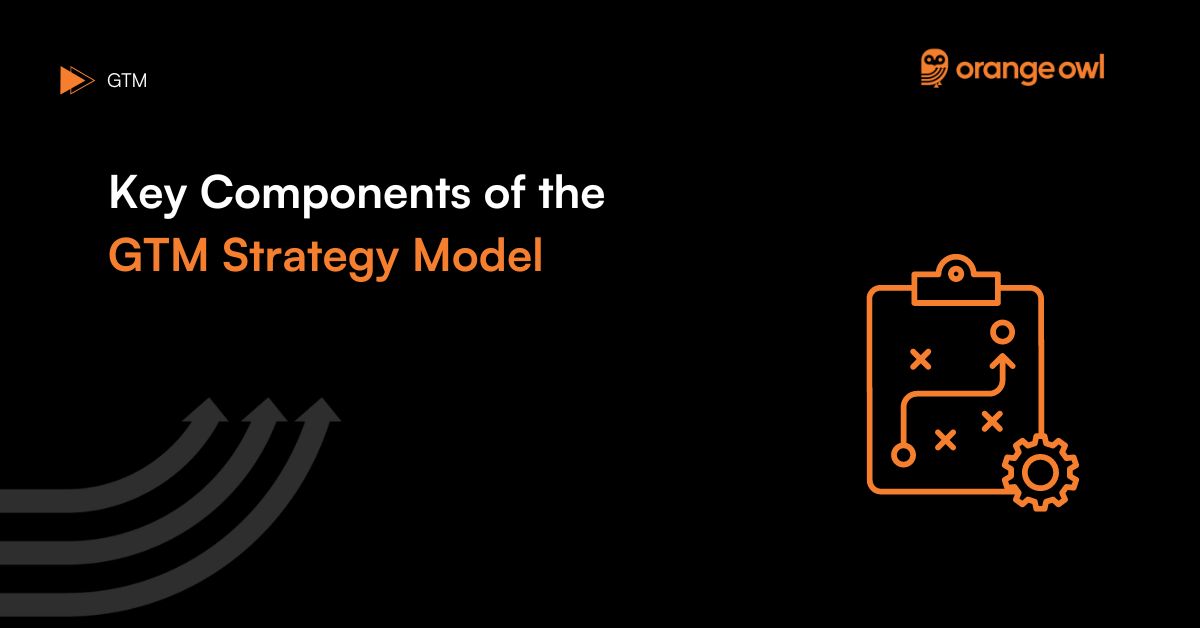Key Components of the GTM Strategy Model
Vivek Goel
February 1, 2025

Table of Contents
In the fast-paced world of B2B business, an effective Go-To-Market (GTM) strategy is crucial for achieving market penetration, customer acquisition, and revenue generation. Let’s delve into the GTM Strategy Model tailored specifically for B2B success, highlighting its key components and how they contribute to a successful market entry and sustainable growth.
Understanding the GTM Strategy Model
At its core, the GTM Strategy Model outlines the framework and roadmap for bringing your product or service to market effectively. It encompasses a series of interconnected steps designed to maximize market penetration, customer acquisition, and revenue generation. Here’s an in-depth look at the key components of this model:
Key Components of the GTM Strategy Model
1. Market Segmentation:
Identify and segment your target market based on criteria such as company size, industry vertical, and buyer personas. This helps in tailoring your marketing efforts to address the specific needs and pain points of different market segments.
2. Value Proposition:
Clearly articulate the unique benefits and competitive advantages of your product or service relative to competitors. A strong value proposition differentiates your offering in the market and communicates why customers should choose your product over others.
3. Positioning Strategy:
Define your market positioning relative to competitors. Highlight your differentiation factors and target customer segments. Effective positioning ensures that your product occupies a distinct place in the minds of your target audience.
4. Distribution Channels:
Outline the channels through which you will distribute and sell your product or service to your target market. Selecting the right distribution channels is crucial for reaching your audience effectively and efficiently.

5. Marketing and Sales Plan:
Develop strategies for marketing and sales, including tactics, campaigns, and key performance indicators (KPIs). This plan should detail how you will create value, engage customers, and achieve your strategic objectives.
6. Launch Plan:
Create a comprehensive plan for launching your product, including pre-launch activities, launch events, and post-launch promotions. A well-executed launch plan is critical for generating initial market traction and driving early sales.
Additional Considerations
In addition to the core components, here are some additional aspects to consider for a comprehensive GTM strategy:
1. Why Are You Launching This New Product?
Align your new product with your overall business strategy and objectives. Clearly define the reasons for the launch and how it fits into your long-term goals.2.
2. Pricing Strategy:
Determine a pricing strategy that reflects your product’s value and market positioning. Pricing should be competitive yet reasonable, signaling the overall value of your product to consumers.
3. External Marketing Plan:
Focus on creating brand recognition through content, ads, PR, and events. An effective marketing plan covers branding, lead generation, content, marketing site, and promotional activities.
4. Sales and Support Strategies:
Outline your sales process and support strategies. Ensure that your sales team has the necessary resources, tools, and training to effectively sell and support your product.
5. Customer Support:
Plan for increased support demands post-launch. Include strategies for support and onboarding, tools, satisfaction measurement, and retention to ensure a positive customer experience.
6. Product Fit in the Roadmap:
Prioritize post-launch activities based on feedback from employees and the market. Continuously refine and improve your product to maintain its relevance and competitiveness.
7. Success Metrics:
Define clear metrics to evaluate the performance of your GTM strategy. Metrics should be motivational, meaningful, operational, and measurable, helping you track progress and make data-driven decisions.
8. Support for Recently Launched Product:
Continue to support your product after the launch with adequate resources, budgets, and commitments. Ensuring ongoing support and enhancements helps sustain your product’s success in a competitive market.
Conclusion
The GTM Strategy Model is an essential tool for B2B businesses aiming to successfully enter the market and achieve sustainable growth. By understanding and implementing the key components outlined above, companies can effectively navigate market dynamics, engage target audiences, and drive revenue growth. A well-defined GTM strategy not only helps in achieving immediate sales goals but also lays the foundation for long-term success and customer loyalty.
Frequently Asked Questions (FAQs) about Key Components of the GTM Strategy Model
Market segmentation allows companies to divide their target market into specific groups based on characteristics like industry, company size, and buyer personas. This helps tailor marketing and sales efforts to meet the specific needs and pain points of each segment, leading to more effective and targeted strategies.
Positioning defines how a product is perceived in the market relative to competitors. It involves highlighting differentiation factors and targeting specific customer segments to ensure that the product occupies a distinct and desirable place in the minds of the target audience.
When selecting distribution channels, consider factors like target market preferences, channel reach, cost-effectiveness, and alignment with overall business strategy. The right channels ensure efficient and effective delivery of the product to the end customer.
A marketing and sales plan should include target market analysis, marketing tactics, sales strategies, campaigns, and key performance indicators (KPIs). This plan details how the company will create value, engage customers, and achieve its strategic objectives.
A launch plan outlines the steps for bringing a product to market, including pre-launch activities, launch events, and post-launch promotions. A well-executed launch plan generates initial market traction, drives early sales, and sets the stage for long-term success.
Effective customer support strategies include robust onboarding processes, accessible support tools, regular satisfaction measurement, and ongoing retention efforts. Ensuring a positive customer experience post-launch helps maintain customer loyalty and satisfaction.
Success metrics are defined based on the strategic goals of the GTM strategy. They should be motivational, meaningful, operational, and measurable. Common metrics include customer acquisition cost (CAC), customer lifetime value (CLV), market share, and sales growth.




